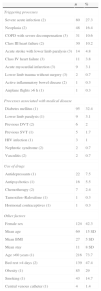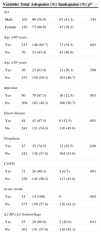Hospitalized patients are a population at risk for venous thromboembolism (VTE). The PRETEMED-2007 clinical practice guidelines help identify high-risk medical patients who are suited to thromboprophylaxis. These guidelines therefore provide a standard for prophylaxis in such patients. We evaluated the risk of VTE and the adjustment of thromboprophylaxis to the standards of the PRETEMED-2007 guidelines in patients hospitalized in internal medicine departments.
Patients and methodsAn observational, cross-sectional multicenter study was performed in 2010 in 16 hospitals in Andalusia and included 20 consecutive patients per center. The study variables were age, sex, risk factors for VTE and hemorrhage, the risk-adjusted PRETEMED of VTE, adjustment of thromboembolic prophylaxis at admission and at discharge and hospital mortality.
ResultsThe study included 293 patients (57.8% men) with a mean age of 69 (±15) years. The most common triggers for VTE were acute severe infection (27.3%) and neoplasia (16.4%). Some 43.4% of the patients presented a risk of hemorrhage. The risk of VTE at admission and discharge was high in 47.8% and 31% and moderate in 8.2% and 10.6%, respectively. A total of 91.7% and 17.3% of the patients underwent prophylaxis with low-molecular-weight heparin on admission and at discharge, respectively. The prescription was appropriate for 59.9% of the patients at admission (overutilization 38.4%, underutilization 1.7%) and for 74.7% at discharge (overutilization 5.4%, underutilization 19.9%). The adjustment was greater in patients older than 60 years and with greater hemorrhagic risk.
ConclusionsFor 60% of the patients admitted to the departments of internal medicine in Andalusia, the thromboprophylaxis was appropriate. The inadequacy of thromboprophylaxis (40%) is mostly due to overutilization. These results suggest significant space for improvement.
Los pacientes hospitalizados constituyen una población de riesgo para la enfermedad tromboembólica venosa (ETV). La guía de práctica clínica PRETEMED-2007 permite identificar a los pacientes médicos de alto riesgo susceptibles de tromboprofilaxis, y así disponer de un estándar de profilaxis en tales pacientes. Hemos evaluado el riesgo de ETV y la adecuación de tromboprofilaxis a los estándares de la guía PRETEMED-2007 en los pacientes hospitalizados en servicios de medicina interna.
Pacientes y métodosEstudio observacional transversal y multicéntrico realizado en 2010 en 16 hospitales de Andalucía que incluyen 20 pacientes consecutivos por centro. Variables: edad, sexo, factores de riesgo de ETV y hemorragia, riesgo ajustado PRETEMED de ETV, adecuación de profilaxis tromboembólica al ingreso y al alta y mortalidad intrahospitalaria.
ResultadosSe incluyeron 293 pacientes (57,8% varones, edad media de 69±15 años). Los factores precipitantes de ETV más frecuentes fueron: infección aguda grave (27,3%) y neoplasia (16,4%). El 43,4% presentaba riesgo de hemorragia. El riesgo de ETV al ingreso y alta fue elevado en el 47,8 y 31% y moderado en el 8,2 y 10,6% respectivamente. Recibieron profilaxis con heparina de bajo peso molecular el 91,7% al ingreso y el 17,3% al alta. La prescripción fue adecuada en el 59,9% al ingreso (sobreuso 38,4%, infrauso 1,7%) y en el 74,7% al alta (sobreuso 5,4%, infrauso 19,9%). La adecuación fue mayor en pacientes mayores de 60 años y con mayor riesgo hemorrágico.
ConclusionesEn el 60% de los enfermos que ingresan en los servicios de medicina interna de Andalucía la tromboprofilaxis es adecuada. La inadecuación de tromboprofilaxis (40%) es mayoritariamente por sobreindicación. Estos resultados sugieren un amplio campo de mejora.
Article
Diríjase desde aquí a la web de la >>>FESEMI<<< e inicie sesión mediante el formulario que se encuentra en la barra superior, pulsando sobre el candado.

Una vez autentificado, en la misma web de FESEMI, en el menú superior, elija la opción deseada.

>>>FESEMI<<<










